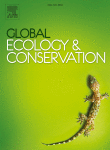Resource information
This study determined pre-conflict, conflict and post-conflict land use change and analysed the impact of armed conflict on the intensity of land use change in northern Nimba County. Landsat images of 1986, 1990, 2002 and 2016 were classified into four dominant land use categories in the study area: cultivation, mine, forest and settlement using maximum likelihood classification algorithm. Land use change was determined by deriving pre-conflict, conflict and post-conflict transition matrix. Based on the transition matrix, gain, loss, persistence, total change, swap and absolute value of net change were computed. Intensity of land use change was determined using the intensity analysis approach. The results show that the intensity of land use change was slow during the conflict but increased sharply after the conflict. Pre-conflict, conflict and post-conflict mine occupied 0.63%, 0.78% and 17.68%, forest cover accounted for 71.08%, 69.26% and 56.42% and settlement was 1.99%, 1.96% and 25.63% respectively. Similarly, pre-conflict, conflict and post-conflict uniform intensity of land use change was 4.09%, 1.51% and 5.01% respectively. Recent forest cover loss is primarily driven by sustained settlement expansion. The implications of rapid post-conflict settlement increase and forest loss in northern Nimba County include threat to habitat in a globally important biodiversity hotspot, increasing pressure on available agricultural land because of increasing population and potential exposure of the population to pollution from increase in mining activities. Therefore, more effective forest management strategies need to be developed to mitigate the prevailing trend. The use of intensity analysis has provided insights on the patterns and processes of pre-conflict, conflict and post-conflict land use change in a biodiversity hotspot. This is important for defining effective conservation goals, planning sustainable conservation strategies and deploying relevant tools for forest conservation and governance in conflict and conflict prone areas.


